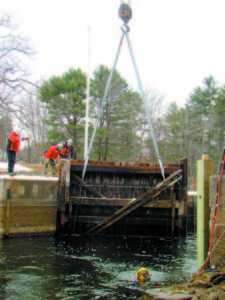Historic ‘Lock’ gets new gates
Staff Writer
NAPLES — The gates at the Songo Lock have swing open and closed for thousands of boaters each year.
Built in 1961, for 57 years those gates have accomplished the job of allowing boaters to continue their journey at a junction in the Songo River where the water levels are different.
This month, the Songo Lock gates were replaced with new ones.
“The age of the gates was the primary reason for deciding to replace them. These gates were installed in 1961 and we felt that, based on age and wear and tear, we should be proactive and replace them before there were issues,†according to Sebago State Park Manager Matt McGuire.
The Songo Lock is maintained and operated by the Maine Bureau of Parks and Lands, under the Department of Agriculture, Conservation, and Forestry.
The total project cost was $131,794.00, according to McGuire.
Wyman & Simpson, Inc., of Richmond, was awarded the bid. Wyman & Simpson subcontracted Andy Buck, Custom Timber Framer to build the replacement gates. Buck’s business is based in Naples. Also involved in the project was Waterworks Diving Service, Inc., out of Portland.
McGuire took on the role of site manager for the Bureau of Parks and Lands.

CRANE REMOVES OLD GATE of the Songo River Lock on Friday. Wyman and Simpson Inc., of Richmond, was the contractor for this project. The gate replacement job was done with the assistance of a diver who is shown in the water. (De Busk Photo)
“I have been on-site for all major aspects of the project including the underwater photography of the door sills to check their viability (carried out by the Maine Warden Service dive team), under water door measurements and inspection, removal of the old doors, and installation of the new doors,†McGuire said.
“What has made the biggest impression on me is the size of the doors,†he said. “The downstream doors weighed 12,000 and 11,700 pounds each when removed. Working around them every day, you lose sight of how large they really are.â€
McGuire thinks that people traveling via the lock will definitely catch sight of the new gates.
“The new doors are highly-visible and boaters pass right alongside them. The new wood and hardware are hard to miss,†he said.
Each season, approximately 4,800 boats utilize the lock, he said.
“I am sure the staff will receive many questions and comments; and, I anticipate that visitors will appreciate the work,†McGuire said.
“The contractors have done a great job and the project has gone well,†he said. “The doors we pulled out matched the shop drawings, which shows the craftsmanship 60 years ago, and the new doors are also very well-made,†he said.
“The framing for the doors took a couple of weeks. Then the contractor was on site assembling the doors at the end of November, and the installation took us through the third week in December,†McGuire said.
Project Manager Josh Marceau, with Wyman and Simpson, said the job took about a month, including the timber work done by Andy Buck at his shop. Wyman and Simpson was the main contractor for the Naples bridge replacement and Causeway renovations in 2010 through 2013.
“All in all, the project has gone well and we believe the park will be quite happy with the performance of their new gates,†Marceau said
He compared the Songo Lock job to other construction projects.

ONE GIANT GATE – The enormity of the Songo Lock gate is apparent when a person is standing next to it, as seen here when the gates that were built in 1961 were removed. (Photo courtesy of Sebago State Park Manager Matt McGuire)
“As with many of our projects a lot of this work was underwater (or underground in some instances) and we weren’t going to be 100% certain of some features of the work until the existing gates were removed,†he said.
“The gates were removed and the crew had to assess the state of the bearings and then make minor adjustments to the new gates to assure a proper fit,†he said.
“During the install they had to overcome challenges of buoyancy, water current and visibility,†he said.
“This project was similar to other projects in the way of being used to working around water and utilizing cranes and other equipment to maneuver large/heavy objects — but, in addition, the necessity to problem solve and adjust the work plan as challenges arose,†Marceau said.
Most replacement projects opt for concrete or another long-lasting material instead of wood. However, wood works for the Songo Lock since the seams swell and become more waterproof when the wood comes in contact with the water.
“I would say the timber-frame portion and historical nature of the project stood out as different than the majority of our work. We recently completed a project on Peaks Island that included a lot of pressure-treated timbers and wooden pile,†Marceau said, “But the difference here was the fine joinery and the necessity to use some very old specialized hardware from the existing gates.â€
History has moved through lock
The Songo Lock has a history that is rich in commerce and tourism.
It is the only remaining, operating lock of system that once had 28 locks.
The Maine Bureau of Parks and Lands has maintained and operated the lock since about 1960.
“The Songo Lock began operation in 1830 as part of the Cumberland and Oxford Canal System. Goods were moved from Portland harbor and ‘lifted’ up, though a series of 28 locks, to Harrison. Raw materials heading downstream were ‘lowered,’†according to Sebago State Park Manager Matt McGuire.
“The Songo Lock was in operation moving flat-bottomed canal boats until the mid-1800s, at which point the majority of goods were beginning to be moved by rail,†he said.
“During the late 19th and early 20th century, the Songo Lock was used by boaters and passenger steamships to travel between Long Lake, Brandy Pond, and Sebago Lake,†he said.
Significant reconstruction was done at the turn of the last century.
“Major work at the lock was performed in 1911, capping the original split granite structure with the current concrete design,†McGuire said.
“The Lock was owned and operated by the S.D. Warren Company until 1960, at which point it was given to the State of Maine to be operated for recreational boaters,†he said.
Wood gates treat environment well
One challenge when constructing structures that come in contact with water bodies is how to not negatively impact the natural environment.
The Songo Lock gates were installed in the 1960s before federal clean air and clean water legislation went into place.
Last week, those gates were removed. Earlier this week, the new gates were put in place.
Naples resident Andy Buck, who owns a small business called Andy Buck, Custom Timber Framer, was subcontracted to build the gates.
“Since 2003, pressure-treated lumber has been treated with a copper-based chemical which is generally considered to be more environmentally-friendly than the previous formulation which was arsenic-based,†Buck said.
The old gates were put into the water in the 1960s, he said.
“I don’t know whether that wood was treated or not. But, if it was, the chemical used then is almost certainly one that would be frowned on today,†he said.
The main contractor, Wyman and Simpson, Inc., “provided the pressure-treated timbers for the two pairs of gates,†Buck said.
There were a handful of reasons that Buck agreed to be part of the Songo Lock gate replacement project.
“When Wyman and Simpson contacted me early in the summer to ask if I would be willing to take on the job of building the framework for the new gates, I immediately said, ‘Yes,’†he said.
“Partly because I have fond memories of spending time fishing there as a boy,†he said, “but more so because of some unique challenges the job presented.â€



